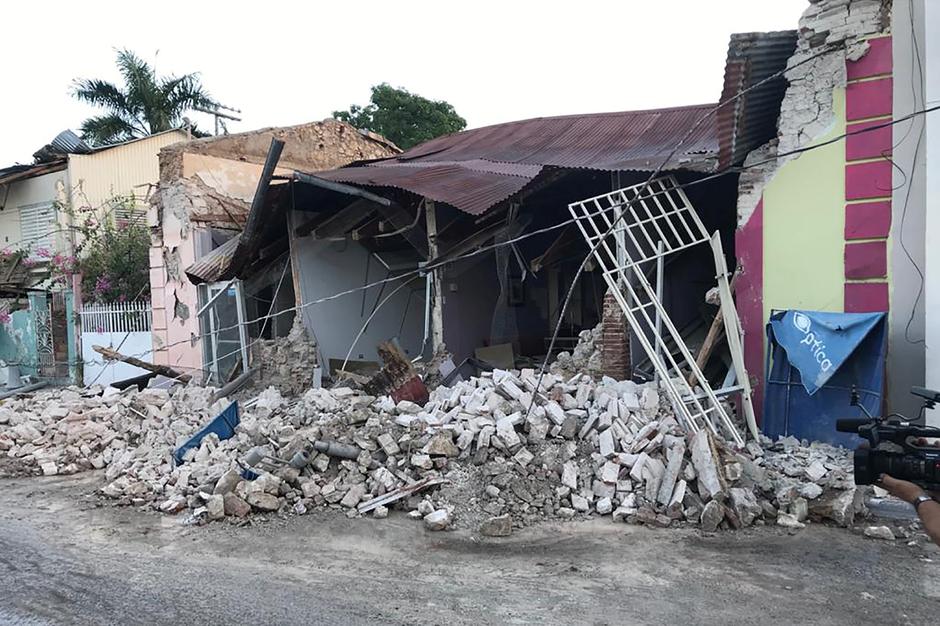SAN JUAN, Puerto Rico, (Reuters) – Puerto Rico Governor Wanda Vazquez declared a state of emergency and activated the National Guard today after a series of earthquakes including one of magnitude 6.4 that was the most powerful to strike the Caribbean island in 102 years.
The temblors killed at least one person, provoked a protective power outage across the entire island and cut off drinking water to 300,000 customers, Vazquez told a news conference, where she also announced the emergency measures.
At least 346 people were left homeless, officials said.
The declaration of emergency will facilitate financial aid for the U.S. territory, and Vazquez said she had already been in contact with the U.S. Federal Emergency Management Agency.
The island has been rocked by a series of quakes – literally hundreds – since Dec. 28, including 10 of magnitude 4 or greater, the U.S. Geological Survey said. A 5.8-magnitude temblor on Monday damaged some homes on the southern coast.
Powerful quakes are rare in Puerto Rico, and Tuesday’s 6.4 was the strongest in more than a century, the island’s seismology office Red Sismica said. On Oct. 11, 1918, a 7.3 magnitude quake and tsunami killed 116 people, according to Red Sismica data.
The U.S. territory is still recovering from a pair of devastating 2017 hurricanes that killed about 3,000 people and destroyed a significant amount of infrastructure. Puerto Rico is also working through a bankruptcy process to restructure about $120 billion of debt and pension obligations.
“We are a resilient people. We have responded to many difficult situations. Now this has been asked of us one more time,” Vazquez said.
One of Tuesday’s quakes triggered an automatic shutdown of electricity across the island as a safety measure, and a later, more powerful quake caused significant damage to some power plants in the southern part of the island, Vazquez said.
Some 300,000 of Puerto Rico’s 1.3 million water customers lacked service, she said. The governor confirmed one death, as reported by El Nuevo Dia, that a 73-year-old man died after a wall fell on him.
But she said it was too soon to offer an accurate assessment of damage or injuries.
Vazquez, who assumed office in August after Ricardo Rossello stepped down in the face of massive street protests, repeated pleas for people to remain calm.
“Nothing is gained by creating hysteria,” she said, while asking people to on check on their neighbors, especially the elderly.
The first and biggest quake on Tuesday, of magnitude 6.4, struck at a depth of 10.0 km (six miles) at 4:24 am (0824 GMT) near Ponce on the island’s southern coast, the U.S. Geological Survey said.
Witnesses on social media described the quake as “super strong” and lasting up to 30 seconds. It was followed by a number of hefty aftershocks including one measuring 5.8.
The impact along the country’s southern coast appeared significant.
The quake severely damaged the Immaculate Conception church in Guayanilla, leaving about half of it standing and surrounded by piles of rubble, according to video posted by Wapa TV. A picture published by El Nuevo Dia showed people removing artifacts.
At least eight homes collapsed in Yauco, El Nuevo Dia reported, citing Mayor Angel Torres. Wapa TV video showed one home in Yauco flattened, its roof intact atop debris and slanting until it touched the ground.
The international airport in Carolina, just east of San Juan, continued normal service with the help of power generators, El Nuevo Dia reported, citing Jorge Hernandez, chief executive of Aerostar Airport Holdings.
In the town of Guanica, several buildings collapsed. Further east in Maunabo, video on social media showed people evacuating to higher ground following a tsunami warning.
The Pacific Tsunami Warning Center reported a small tsunami measuring around 20 centimeters (7.9 inches).









